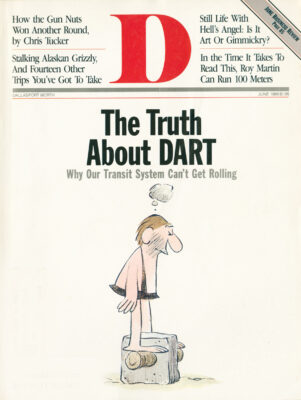If you must use the word at all in Dallas business circles, whisper it with averted eyes, as you would say
“impotent,” or “cancer.” We’re talking, of course, about Houston. The mere mention of the word conjures up images of
long unemployment lines, FHA fire sales of repossessed homes, and bankruptcy courts hopelessly clogged with failures
from all walks of industry. Yes, Houston is a seriously depressed city, reeling from free-falling oil prices, a
decimated refining industry, and a badly tarnished reputation. So go easy when you suggest that Houston’s economic
malaise could infect Dallas.
Dallas business leaders say it couldn’t happen here, but in their unspoken nightmares they’re not so sure. One day
brings news of large layoffs at the Arlington General Motors plant. The next day, speculation runs wild that this
bank or that is on the brink of a federal takeover. And then there is real estate. Everywhere, empty buildings;
every day, rumors of a new developer at the brink of bankruptcy.
Is Dallas another Houston waiting to happen? No. To be sure, me Dallas economy will be down for a while. A city with
strong oil patch ties during an oil patch depression is going to suffer. Dallas’s luster will fade somewhat as the
overall Sunbelt luster fades, But an economic failure of Houstonian proportions just isn’t in the cards.
Dallas And Oil
Are we simply whistling in the dark? Look at the numbers. In 1985, only 1.6 percent of jobs in Dallas had to do with
the extraction of oil and gas; in the Houston-Galveston area, 6.2 percent of workers owed their livelihoods to
extraction. High-tech hype aside, 20 percent of the Dallas/Fort Worth economy is connected to manufacturing, and
none of that has anything to do with oil and gas. Houston’s far less potent manufacturing sector (12.3 percent of
its jobs) is heavily tilted toward energy. In the Houston-Galveston PMSA, almost a quarter of all jobs are
energy-related. Contrast that with Dallas, where just 6.3 percent of jobs are beholden to energy. Clearly, oil flows
in one vein of the Dallas economy. It’s the major artery in Houston, and when that artery dries up, economic cardiac
arrest must follow.
If Houston’s manufacturing sector has been smashed by falling energy prices, so has its service sector. One study
suggests that 60 percent of all leased office space within the Houston city limits is directly or indirectly related
to the oil and gas industry. This would include that percentage of law, accounting, investment banking, and
consulting activities dedicated to oil and gas clients. As the cash flowing through the energy companies has shrunk,
so have the staff requirements of the service sectors and the requirements for office space. By contrast, probably
no more than 12 percent of all leased office space in Dallas is so closely tied to the oil and gas industry.
Dallas does have some large energy companies, especially in the area of oil field servicing. Dresser, Halliburton,
and Fort Worth’s Western Company are among the largest in that segment of the energy industry. Dallas is also home
to a fair number of larger independents. Even electronic giant Texas Instruments still has significant operations in
energy instrumentation. Dallas, like Houston, will continue to see a retrenchment in its energy industry that will
send ripples through the local economy. But since energy is just one pillar of the economic temple, the suffering in
Dallas should be far less.
Dallas does share at least one major negative consequence of the oil downturn with Houston: a damaged banking
sector. With the exception of Dallas’s RepublicBank, most large Texas banks invested heavily in oil and gas ventures
of all sizes and descriptions. Backing energy-oriented companies was something the world assumed Texas bankers knew
more about than anyone else. So Texas banks backed anyone who walked in off the street with half apian to peddle
some “mud” (used in drilling) or sink a hole. Many Dallas bankers, like their Houston counterparts, seemed confident
that the good times would roll forever.
Dallas And Defense
Dallas, though conservative and increasingly Republican, should think twice before applauding Sen. Phil Gramm’s
scheme for cutting the deficit. Gramm-Rudman’s almost certain result will be a major slashing of defense spending,
especially for weapons systems, and that will cut to the heart of the Dallas economy even as the energy shock has
cut the legs from underneath Houston.
Large defense contractors in the Dallas/Fort Worth area include General Dynamics, Bell Helicopter Textron, LTV
Aerospace And Defense. Rockwell International. Texas Instruments, and E-Systems, not to mention a host of lesser
lights. All told, the Dallas/Fort Worth area receives nearly $5.2 billion each year in federal defense dollars. In
the period beginning in 1980 and ending with the third quarter of 1985, electronics, transportation, and
instrumentation, overwhelmingly defense-related, accounted for 36.8 percent of Dallas/Fort Worth’s manufacturing
employment base, versus a Houston figure of only 9.8 percent. Dallas/Fort Worth faces no immediate danger of a
sudden drop in defense dollars. However, it seems almost certain that Congress will not accept additional cuts in
domestic spending without substantial cuts in defense. The money already appropriated for major contracts held by
Dallas-area contractors will flow for two to three more years. No serious downturn will occur before 1988 or
1989-assuming, of course, that Congress can reach a budget-cutting accord. Otherwise, the Gramm-Rudman
across-the-board ax would fall. Many existing contracts in the Dallas/Fort Worth area would be spared, but deep cuts
would occur.
Dallas And Real Estate
Construction now under way in Dallas will bring nearly 18 million square feet of new commercial space, nearly 1
million square feet of industrial warehouse space, and more than 36.000 new homes, most of it to be completed during
the first half of 1987. But few significant projects are likely to get under way between now and then. Commercial
construction will almost certainly grind to a halt. Retail is fast becoming overbuilt, and as the overall economy
softens, retail sales will drop and retail leasing will decrease, making it especially hard on some high-end
projects now pulling high rates. Enough projects remain in the pipeline to sustain construction industry employment
for at least another year, but a dramatic decrease will follow after that.
There are several factors at work here. Real estate development is driven-or driven down-by the availability of
financing. Right now, and for the foreseeable future, money for starting new commercial, retail, and industrial
projects in the Dallas/Fort Worth area is simply not available. By early next year Dallas proper will have a
six-year supply of office space available at current absorption rates of around 9 million square feet per year. That
removes whatever market forces might make money available. But the lending institutions themselves are no longer
able to make real estate loans. Bank examiners are putting heavy pressure on banks and savings institutions to opt
out of development loans, and are requiring projects that are funded to receive that funding based on likely cash
flows rather than asset values.
The giant development organizations, with their deep pockets, will stay afloat by seeking out attractive projects in
other parts of the country where funding can still be obtained. Smaller operators tied to the Dallas area could well
face bankruptcy. Even harder hit will be the vast network of businesses that live off the real estate industry:
architects, office planners, interior designers, leasing companies, lawyers, and accountants.
Absorption trends also worry many analysts. Many fear Dallas’s 9 million-square-foot absorption rate will drop,
adding even more to what is already the largest glut in the nation. Since the in-migration of businesses from other
areas has all but come to a halt, absorption is coming almost exclusively from expansion by local firms, with
finance companies and firms related to real estate leading the way. A private, unreleased study of Dallas leasing
trends suggests that as much as 40 percent of all Dallas commercial space may be occupied by firms directly or
indirectly related to development. Any serious downturn in real estate will quickly reduce the absorption rate.
Still, things are much worse 300 miles southeast. Houston’s construction is almost at a standstill, and current
commercial absorption there is in negative numbers.
Opportunities
Times may get a lot rougher before they get a lot better, but we have some silver linings. The cost of living in
both Dallas and Houston is headed down after several years of inflation rates far above the national average.
Property values, especially residential values, are falling, and that provides a relative advantage when competing
against other areas of the nation where values are rapidly increasing. The slower growth will also allow both cities
to address infrastructure needs. The boom times brought fast growth, so fast that the very quality-of-life assets
that made the Sunbelt so attractive to begin with were rapidly eroded.
Declining property values in both Dallas and Houston will also create a powerful lure for foreign investors. These
investors, having bought their stake in the Sunbelt, have a strong incentive to locate facilities here to make use
of their in vestments. In time, this could mean a new, inter nationally oriented economy with major new economic
segments and new horizons for new comers and the already established.
Get our weekly recap
Brings new meaning to the phrase Sunday Funday. No spam, ever.
Related Articles

Arts & Entertainment
‘The Trouble is You Think You Have Time’: Paul Levatino on Bastards of Soul
A Q&A with the music-industry veteran and first-time feature director about his new documentary and the loss of a friend.
By Zac Crain

Things to Do in Dallas
Things To Do in Dallas This Weekend
How to enjoy local arts, music, culture, food, fitness, and more all week long in Dallas.
By Bethany Erickson and Zoe Roberts

Local News
Mayor Eric Johnson’s Revisionist History
In February, several of the mayor's colleagues cited the fractured relationship between City Manager T.C. Broadnax and Johnson as a reason for the city's chief executive to resign. The mayor is now peddling a different narrative.


